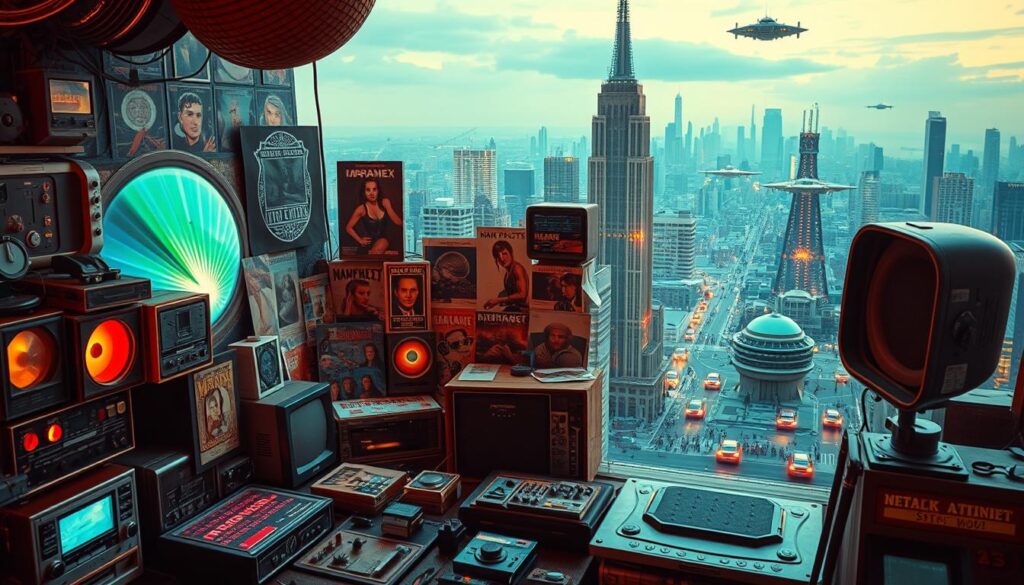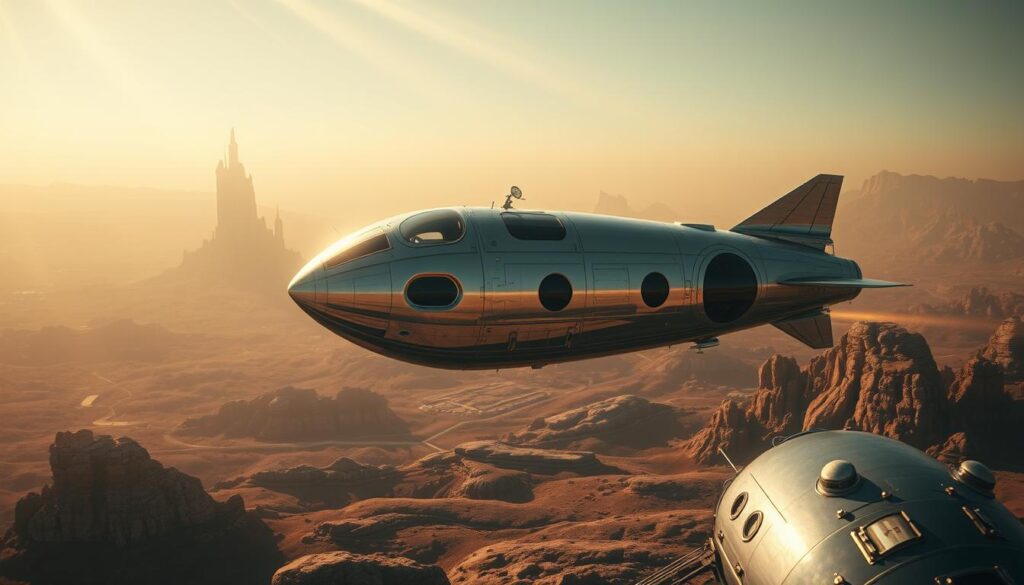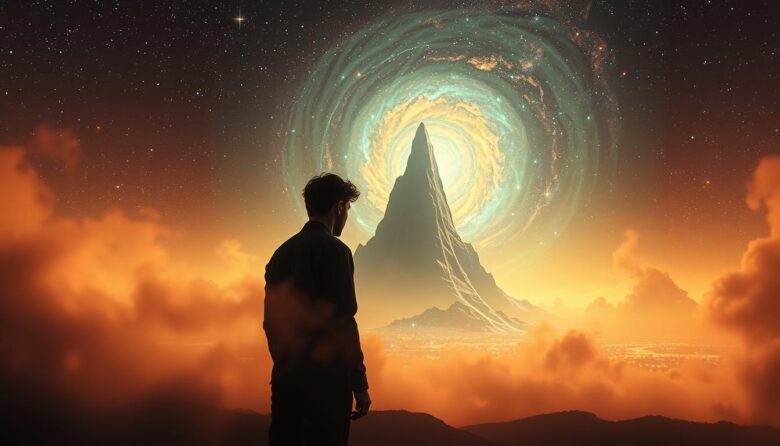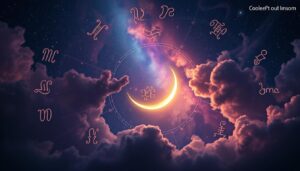Why do stories about distant planets and starships stir such vivid emotions? The Psychology of Intergalactic Nostalgia explores how our brains connect with cosmic journeys. It blends personal memories with humanity’s shared dreams of space. This journey starts where science fiction meets real exploration—from Apollo missions to Hubble’s cosmic snapshots.
Space isn’t just a frontier for rockets. It’s a mirror reflecting our longing for the unknown. Movies like 2001: A Space Odyssey and shows like Star Trek shape how we remember the future. This article uncovers why these stories resonate so deeply, merging psychology with our collective fascination with the stars.
Key Takeaways
- Intergalactic nostalgia links personal feelings to humanity’s space ambitions.
- Sci-fi media deeply influences how we imagine and remember space exploration.
- Memories of past missions, like Apollo 11, fuel hopes for future discoveries.
- Emotions tied to space stories help people cope with change and seek connection.
- Understanding this nostalgia reveals how imagination shapes cultural identity.
Introduction to Intergalactic Nostalgia
Intergalactic nostalgia is more than just stars and rockets. It’s a deep longing for futures we’ve never seen but vividly imagine. This mix of real space achievements and sci-fi dreams shapes our view of exploration today.
What is Intergalactic Nostalgia?
It’s a mix of personal memories of space milestones and hopes from science fiction. It’s the feeling of missing a future that never was, yet feels familiar. For instance, seeing a spacesuit might remind someone of childhood trips to planetariums or classic sci-fi movies.
The Role of Science Fiction in Shaping Memory
Sci-fi stories are blueprints for our cosmic dreams. They turn abstract ideas into emotional connections. Here’s how:
- Star Trek made warp drives and alien diplomacy feel real.
- 2001: A Space Odyssey
turned cold machinery into symbols of human ambition.
These stories don’t just entertain—they become part of our cultural memory. When new missions launch, they remind us of fictional adventures, blurring past and future.
Historical Context of Space Exploration
Humanity’s journey into space started with small steps that became giant leaps in memory. From the first satellites to lunar landings, these moments shaped our shared story. The psychology of nostalgia connects these achievements to emotions felt decades later.
Milestones in Space Exploration
- 1957: Sputnik 1, the first artificial satellite, sparked global curiosity.
- 1961: Yuri Gagarin’s orbit marked humanity’s first spaceflight.
- 1969: Apollo 11’s moonwalk became a symbol of human ambition.
- 1986: Challenger and Columbia tragedies highlighted risks, deepening emotional bonds with space.
- 2024: SpaceX’s Crew Dragon missions revived public fascination with space travel.
The Cultural Impact of the Space Race
Competitions between nations turned technical achievements into cultural touchstones. The 1960s moon race wasn’t just science—it became part of pop culture, music, and film. Today, recalling those eras evokes pride and longing, a core theme in the psychology of nostalgia.
“We choose to go to the moon… because that goal will serve to organize and measure the best of our energies and skills.” —John F. Kennedy, 1962
These events created a legacy. Retro rockets in movies like Interstellar or retro-themed space apps today tap into that shared memory. The psychology of nostalgia explains why older missions still inspire awe, blending history with emotional resonance.
Nostalgia as a Psychological Phenomenon
Nostalgia studies show how it connects our past and present. They look into why we remember space missions or childhood adventures. This section makes complex ideas simple.
Understanding Nostalgia
Nostalgia is more than just daydreaming. It’s a mix of happiness and a deep longing. Studies find it often pops up when we’re unsure. Things like songs, old photos, or sci-fi movies can trigger it.
This feeling can make us feel better and help us understand who we are.
- Triggers: Sensory cues like music or smells
- Purpose: Helps people find meaning in life’s changes
Types of Nostalgia: Personal vs. Historical
Personal nostalgia is about individual memories. It could be a family trip or seeing the stars for the first time. Historical nostalgia connects us to big events, like the moon landing or sci-fi milestones.
Both types shape how we see progress and our identity.
- Personal: Memories unique to you, like a childhood backyard stargazing session
- Historical: Shared cultural touchstones, like Apollo 11’s moonwalk
The Role of Science Fiction in Nostalgia
Science fiction stories reflect our hopes and fears about the universe. They shape our space nostalgia, a mix of longing and sadness for futures we’ve never seen. Iconic films and shows capture our imagination, leaving visions of space in our collective memory.
Iconic Sci-Fi Movies and Series
Classic sci-fi works are cultural touchstones. They mix adventure with deep emotions. Think about:
- 2001: A Space Odyssey (1968): Its visuals of lunar bases and AI set the standard for “hard” sci-fi.
- Star Wars (1977): It introduced a galaxy “far away” to our culture, with lightsabers and space battles.
- Star Trek (1966): Its vision of a utopian federation sparks debates about humanity’s future.
How Sci-Fi Shapes Our Memories of the Future
Sci-fi doesn’t just predict the future; it shapes our nostalgia for it. Here’s how:
| Sci-Fi Work | Future Vision | Nostalgia Trigger |
|---|---|---|
| Blade Runner (1982) | Neon-drenched cyberpunk cities | Modern tech like holograms or AI brings back its dystopian charm |
| Interstellar (2014) | Black holes and wormholes | Recent NASA discoveries make us think about its scientific ideas |
These stories create “memory anchors,” emotions linked to imagined futures. When SpaceX launches rockets, fans remember 2001’s space stations. This mix of fiction and reality helps us understand technological progress.
The Emotional Connection to Space
Humans have always been drawn to the stars with a mix of awe and longing. Our emotional bond with space is rooted in our sense of place in the universe. This connection combines personal memories with shared dreams.
Exploring why space evokes nostalgia in many is key to understanding this bond.
Why Space Evokes Nostalgia
Space’s vastness and mystery mirror our curiosity and past. Looking at stars brings back childhood nights under the same sky. This shared experience connects us across generations.
Nostalgia for space is not just about the future. It’s about the memories of feeling small yet connected while looking up.
“The cosmos is within us. We are a way for the universe to know itself.” – Carl Sagan
The Power of Imagination and Memory
Imagination lets us dream of distant planets and alien worlds. Memory connects these dreams to our personal stories. Together, they shape our cosmic connection.
| Emotion | Connection to Space |
|---|---|
| Wonder | Stargazing sparks curiosity about cosmic origins |
| Nostalgia | Childhood memories of starry nights |
| Hope | Imagining humanity’s future among the stars |
Themes of Nostalgia in Popular Media
Sci-fi media connects the past and future through nostalgia. Nostalgia research reveals how this mix makes audiences feel at home in space. It shows how old and new blend to make futuristic settings relatable.

Examples from Film and Television
Many iconic shows and movies revisit familiar themes:
- Star Trek reboots tackle old ethical dilemmas
- Doctor Who combines futuristic tech with 1960s stories
- Interstellar contrasts cosmic wonder with Earth’s fragility
Literature that Sparks Intergalactic Memories
Books like Frank Herbert’s Dune blend desert planets with colonial history. Ursula K. Le Guin’s The Left Hand of Darkness explores alien cultures that reflect Earth’s past. These works make space a mirror for human heritage.
| Medium | Work | Nostalgic Element |
|---|---|---|
| TV | Stranger Things | 1980s sci-fi aesthetics |
| Books | Hyperion Cantos | Poetry referencing Earth’s lost art |
| Movies | Guardians of the Galaxy | Retro music as emotional anchors |
“Sci-fi’s power lies in its ability to make the unfamiliar feel familiar through nostalgia,” notes Nature’s nostalgia research analysis.
These stories show space isn’t just a frontier. It’s a canvas for remembering what we’ve left behind.
The Impact of Nostalgia on Society
Nostalgia does more than just bring back memories. It shapes cultural trends and strengthens community bonds. It influences everything from fashion to technology, guiding our choices today.
Nostalgia is a shared language, connecting generations through shared histories, says Dr. Clay Routledge of North Dakota State University.
Nostalgia as a Cultural Influence
Cultural movements often look back to the past. The 2022 re-release of E.T. the Extra-Terrestrial sparked talks about space exploration’s legacy. Museums like the Smithsonian use old spacecraft to inspire curiosity about our journey.
Seeking Comfort in Familiarity
In uncertain times, we turn to familiar stories. During the 2020s economic changes, streaming saw a 40% rise in 1990s sci-fi series views. These stories offer comfort, blending old and new.
Intergalactic Nostalgia in Gaming
Video games turn intergalactic nostalgia into fun experiences. Players go back to cosmic adventures in their minds. Classic games make memories that last through generations.
Video Games as a Medium of Reflection
Games like Elite Dangerous and No Man’s Sky let players explore space. They mirror real space missions. These games have vast worlds that spark imagination and memory.
Replayable missions and open worlds keep moments of discovery alive. Space memory analysis shows how personal achievements connect to space stories.
Classic Games that Inspire Nostalgia
Games from the 1990s and 2000s are still loved for their stories. Star Wars: Knights of the Old Republic mixes space opera with player choices. This creates deep emotional connections. Here are some games that left a mark on intergalactic memory:
| Game Title | Release Year | Nostalgia Trigger |
|---|---|---|
| Elite: Dangerous | 2014 | Realistic physics and persistent universe |
| Star Wars: KOTOR | 2003 | Jedi quests and moral choices |
| Xenon 2600 | 1992 | Retro visuals and arcade-style exploration |
These games are cultural icons. Through space memory analysis, we see how developers add nostalgia. Each mission or soundtrack marks our shared curiosity about space.
Future Exploration and Nostalgia
As we look to Mars and beyond, future missions could add new chapters to our shared story. These journeys might create intergalactic nostalgia. They will mix new exploration with timeless feelings.

How Future Missions Could Ignite Nostalgia
Future explorers might see Mars or lunar bases as big milestones, like the Apollo landings. Imagine them marveling at the first Mars colony, just as we remember Neil Armstrong’s moonwalk. Each new achievement adds to our cosmic journey, creating moments for future reflection.
Building Historical Context for Future Generations
To keep these stories alive, we must preserve today’s efforts. Here are steps to anchor our progress in history:
- Archiving mission data for educational platforms and museums.
- Creating immersive VR exhibits showcasing today’s innovations.
- Sharing astronaut journals and videos to humanize space’s evolving narrative.
These steps help future explorers understand humanity’s journey. They turn today’s breakthroughs into tomorrow’s cherished memories. By documenting our path, we give posterity a roadmap to their own cosmic heritage.
Therapeutic Benefits of Nostalgia
Nostalgia is more than just looking back. It’s a way to heal emotionally. Studies show that remembering happy times can lower stress and make us feel better. For example, Science Advances found that nostalgia helps us feel closer to others by reminding us of good times together.
This mental practice helps us deal with big changes in life. It’s useful when we start new jobs or face personal losses.
Using Nostalgia to Cope with Change
Here’s how to use nostalgia to stay strong during hard times:
- Keep a journal of past achievements
- Watch old sci-fi films that inspire hope
- Share stories with loved ones about shared experiences
Nostalgia as a Tool for Mental Well-Being
A 2022 study in Emotion showed that nostalgia can make us 34% more resilient. Here’s how it works:
| Benefit | How It Works |
|---|---|
| Mood Boost | Activates brain regions linked to reward and pleasure |
| Social Connection | Recalls times of trust and belonging |
| Future Hope | Uses past joy to imagine positive futures |
Next time you feel stressed, think about your favorite childhood book or a space adventure movie. These actions are not just escapes. They are backed by science and help build mental strength.
Conclusion: The Lasting Power of Intergalactic Nostalgia
Intergalactic nostalgia connects our past achievements to our future dreams. It mixes memories with imagination, showing our place among the stars.
Reflecting on Our Place in the Universe
Space milestones like Apollo 11 and SpaceX’s launches show our progress. Nostalgia for these moments keeps our curiosity alive. It inspires new generations to explore.
Every rocket launch or sci-fi film reminds us of our cosmic journey. It’s a story we never outgrow.
Embracing the Joys of Intergalactic Memories
Sci-fi classics like Star Trek and games like No Man’s Sky create lasting memories. These stories give us hope and connection. Nostalgia is more than the past; it’s a bridge to the future.
Every time we gaze at the stars, it sparks wonder. It reminds us of the magic of space.



